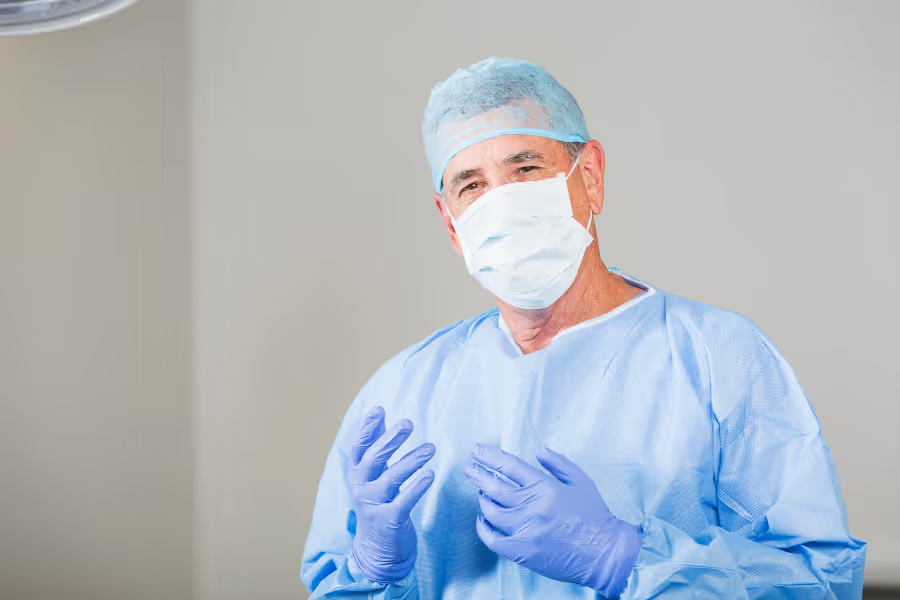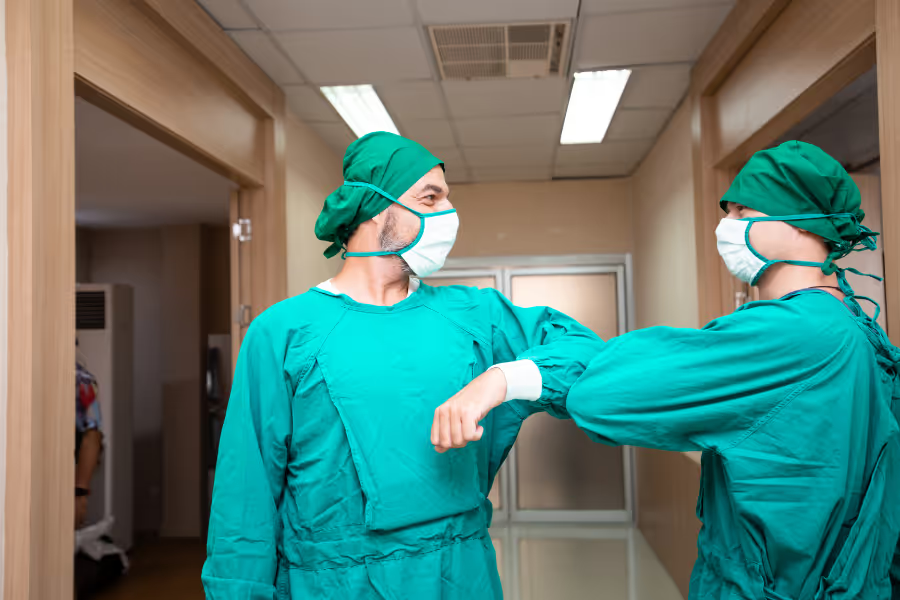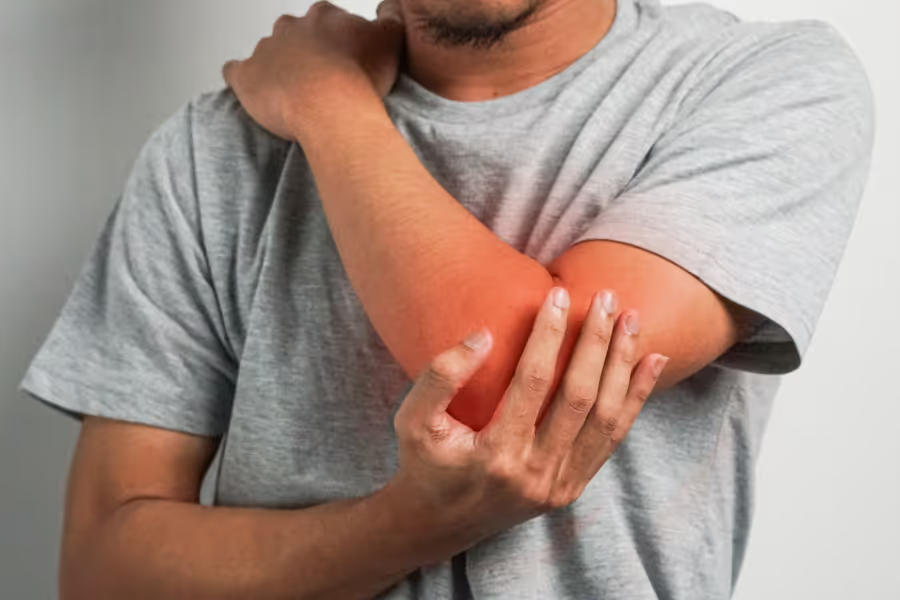Elbow arthroscopy surgery may help if persistent elbow pain, stiffness, catching, or locking is disrupting your sleep, sports, work, and daily activities. Learn more and find the right surgeon that fits your needs below, serving Canadians in major cities like Vancouver, British Columbia; Calgary, Alberta; Toronto, Ontario; and Montréal, Québec.
Informational purposes only, not medical or legal advice. Please consult your doctor or surgeon.

Elbow arthroscopy is a 'keyhole' surgery that lets doctors look inside your elbow joint and fix problems using tiny tools.
Instead of making a big cut, the surgeon makes a few small incisions (about the size of a pencil eraser). A camera called an arthroscope goes through one incision and shows a live, magnified view of your joint on a screen. Through the others, the surgeon slides in instruments to shave bone spurs, remove loose cartilage, smooth rough surfaces, release tight tissues, or wash out inflammation.
Why do it?
It helps with common issues like locking or catching from loose bodies, stiffness from scar tissue, painful bone spurs, tennis elbow that hasn’t improved with therapy, or early arthritis changes. Because the cuts are small, there’s usually less pain and swelling, fewer scars, and a faster recovery than open surgery—though it’s still real surgery and rehab matters.
Elbow arthroscopy often follows lengthy queues. Instead of waiting months for a consultation and OR time, private centers can schedule surgery within weeks—reducing time spent with locking, catching, or night pain, and helping you get back to school, work, or sport sooner.
Going private gives you more say in your care. You can:
Patients value knowing exactly who will operate, when it will happen, and the detailed plan (anesthesia, approach, rehab). This certainty eases anxiety and helps families coordinate time off, support, and physical therapy.
Function and performance: Limits months of pain, motion loss, and grip weakness that derail training, exams, or work.
Joint health: Persistent impingement, loose bodies, or scar tissue can worsen stiffness and cartilage wear; earlier arthroscopy can address mechanical problems before they escalate.
Surgical complexity: Repeated inflammation and scar can make later surgery more extensive, with harder rehab.
Mental load: Reduces time living with uncertainty, restricted activities, and poor sleep from night symptoms.

Most elbow arthroscopies take about 45–90 minutes of operating time. Expect a few extra hours at the surgical centre for check-in, anesthesia, and recovery before you go home.
Basic steps:
Experiences do vary. Your surgery may look different, so consult your surgeon.

Every elbow is different—follow your surgeon’s plan. Taking rehab seriously usually means better results. Some private clinics offer virtual follow-ups or coordinate physio near home. In general, what to expect:
Week 1
Reality check: soreness, stiffness, swelling, and sleep hassles. Not fun.
Goals: control pain and swelling, protect the elbow, start gentle motion.
Activities:
Weeks 2–4
Still annoying but improving.
Goals: restore basic range of motion (ROM), reduce swelling, use the arm for light tasks.
Activities:
Weeks 5–12
The work phase.
Goals: near-full ROM, start strength.
Activities:
Weeks 13–24
Refining strength and confidence.
Goals: full ROM, stronger forearm/arm, sport/work-specific drills.
Activities:
Month 6+
Most people feel “normal-ish,” but keep smart loading and maintenance exercises. Return to full sport or heavy work only when cleared by your surgeon/physio.
Red flags anytime: fever, worsening redness/drainage, severe calf pain/swelling, chest pain/shortness of breath, new numbness/weakness—call your care team.
Elbow arthroscopy is a minimally invasive surgery, however the costs are significant and very because of the potential complexity involved in certain instances. Private clinics in Canada typically charge $6,500 to $9,000.
In the United States, the costs vary even more: CA$7,250 to CA$12,700.
Costs vary so much because of location, surgeon experience, facility type, scope of potential treatments, complexity of the issue, and included services (some clinics offer all-inclusive, while others charge separately for anesthesia, followup care, etc.).
Most quotes for private elbow arthroscopy cover:
What’s usually not included:
Choosing your surgeon is one of the benefits of going the private route. Here’s what to consider and the key questions to bring to your elbow arthroscopy consultation.
Elbow arthroscopy is a minimally invasive surgery where a surgeon uses a tiny camera and tools to look inside your elbow and fix problems. It might be right for you if:
Common reasons people get elbow arthroscopy
When elbow arthroscopy might not be right
No, you do not need a referral for private elbow arthroscopy in Canada. You can book a consultation directly with a surgeon, and they will review your condition, symptoms, and any previous treatments or diagnostics.
Your surgeon will give specific instructions based on your condition and the exact procedure.
Prehab and health optimization
Exercises: You’ll likely be given gentle range-of-motion and strengthening exercises for your shoulder, wrist, and hand to reduce stiffness and improve recovery. Work on swelling control (ice/elevation) if your elbow is puffy.
Stop smoking/vaping: Nicotine reduces blood flow and raises infection and stiffness risks. Quitting 4+ weeks before surgery improves healing.
Medications: Tell your team about all meds and supplements. You may need to pause blood thinners (aspirin, warfarin, DOACs), certain anti-inflammatories, and some herbal supplements that increase bleeding. Only stop meds if your surgeon or family doctor tells you to.
Weight and general fitness: Light cardio and a balanced diet can help reduce risks and speed recovery. Aim for good sleep and hydration.
Home prep
One-handed setup: After surgery, your arm may be in a bulky dressing or sling for a short time. Set up your space to be easy to navigate and one-hand friendly.
Declutter: Remove tripping hazards (cords, sliding rugs, clutter). Keep frequently used items at waist/chest height.
Comfort aids: Ice packs/ice machine, extra pillows to support your arm, a small side table to keep phone/meds/water nearby.
Clothing: Lay out loose, front-opening tops and elastic-waist bottoms; slip-on shoes. Button-ups or zip hoodies are easier one-handed.
Support and logistics
A helper: Arrange for someone to drive you home and stay the first 24–48 hours. Have a backup contact for the first couple of weeks.
Work and school: Plan time off. Desk work may be possible sooner than manual labor, but you’ll need time for swelling control, pain management, and early rehab.
Childcare/pets: Set up help for lifting, walks, and errands for the first 1–2 weeks.
Transportation: Practice fastening the seatbelt and getting in/out of the car with one arm protected.
Food, meds, and surgery-day prep
Fasting: Follow your anesthesia team’s instructions on when to stop eating and drinking (usually no solid food after midnight; clear fluids up to a certain time).
Pain plan: You may receive a nerve block that numbs the arm for 12–24 hours. Have over-the-counter meds (acetaminophen/ibuprofen if allowed) and any prescribed pain meds ready at home before surgery.
Nausea/constipation: Ask for anti-nausea meds if you’ve had issues before. Pick up stool softeners/fibre—pain meds can constipate.
Skin prep: Follow any antiseptic wash instructions (e.g., chlorhexidine) the night before and morning of surgery. Don’t shave the operative arm.
What to bring: Photo ID, insurance (if applicable), medication list, loose top, and your sling (if provided).
Jewelry and nails: Remove rings/bracelets; avoid heavy nail polish or acrylics on the operative hand for monitoring.
Post-surgery practice
One-handed routines: Practice opening containers, preparing simple meals, dressing, and personal hygiene using your non-operative hand.
Sleep position: Try sleeping on your back or the non-operative side with pillows supporting the operative arm.
Your own situation depends on your pain level, motion limits, what’s seen on imaging (loose bodies, bone spurs, cartilage wear, synovitis, scar bands), your sport/work demands, and how well non‑surgical care works (physio, activity changes, meds, injections). Discuss specifics with your surgeon.
Main risks of delaying or not having elbow arthroscopy (when symptoms are significant/persistent)
When watchful waiting can be reasonable
When not to delay
Your individual risk depends on your health, anatomy, exact elbow problem, the procedures done during arthroscopy (e.g., debridement, loose body removal, microfracture), anesthesia, and how closely you follow rehab. Discuss your personal risks with your surgeon.
Common and usually temporary
Less common
Procedure-specific risks (depend on what’s being done)
Uncommon but important
How you can lower risk
Know red flags: fever, worsening pain/swelling, new numbness/weakness, calf pain/swelling, shortness of breath — call your care team or go to the ER if they happen.
Elbow arthroscopy is generally safe and effective for targeted problems, with most issues being mild and temporary. The biggest concerns are stiffness, temporary nerve irritation, infection (uncommon), and—depending on the procedure—the need for disciplined rehab. Your surgeon can explain which risks matter most in your specific case and how they’ll minimize them.
Elbow arthroscopy treats a range of issues in the elbow, and some involve more substantial recovery times than others. Your return to normal activity and sport will depend on your unique circumstances.
In general, you can expect basic arm movement within 2-3 months, retuning to low impact sport within 6-8 months, and full recovery within ~12 months.
Always consult your surgeon and physio for guidance.

Browse vetted elbow surgeons across Canada. Compare prices, qualifications, locations.
BROWSE SURGEONS